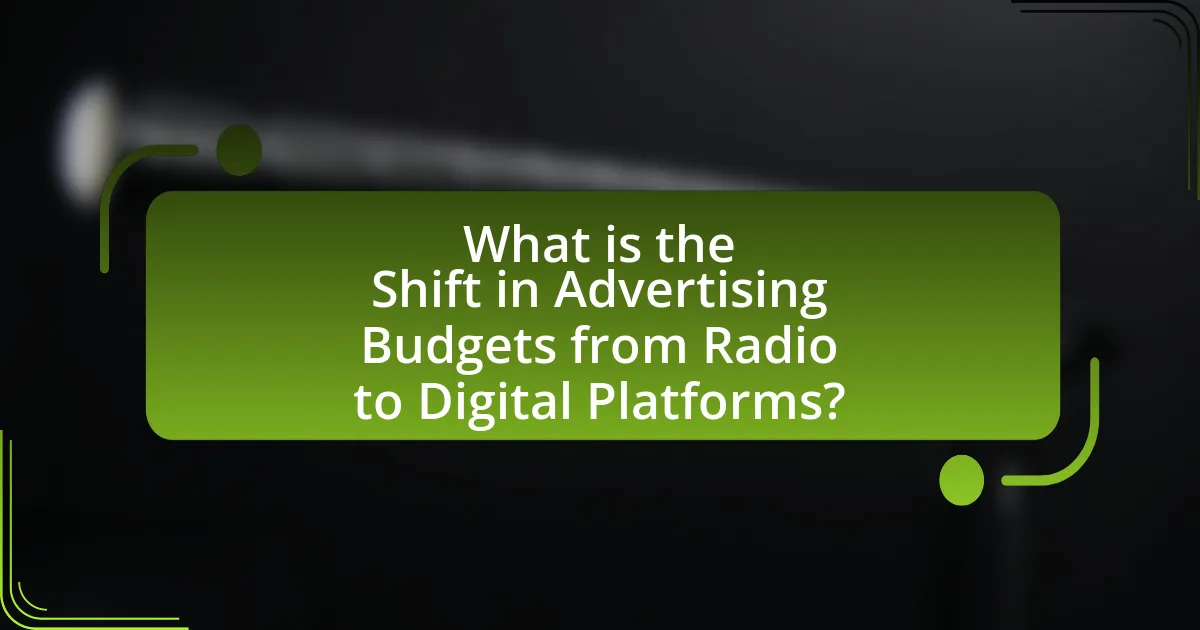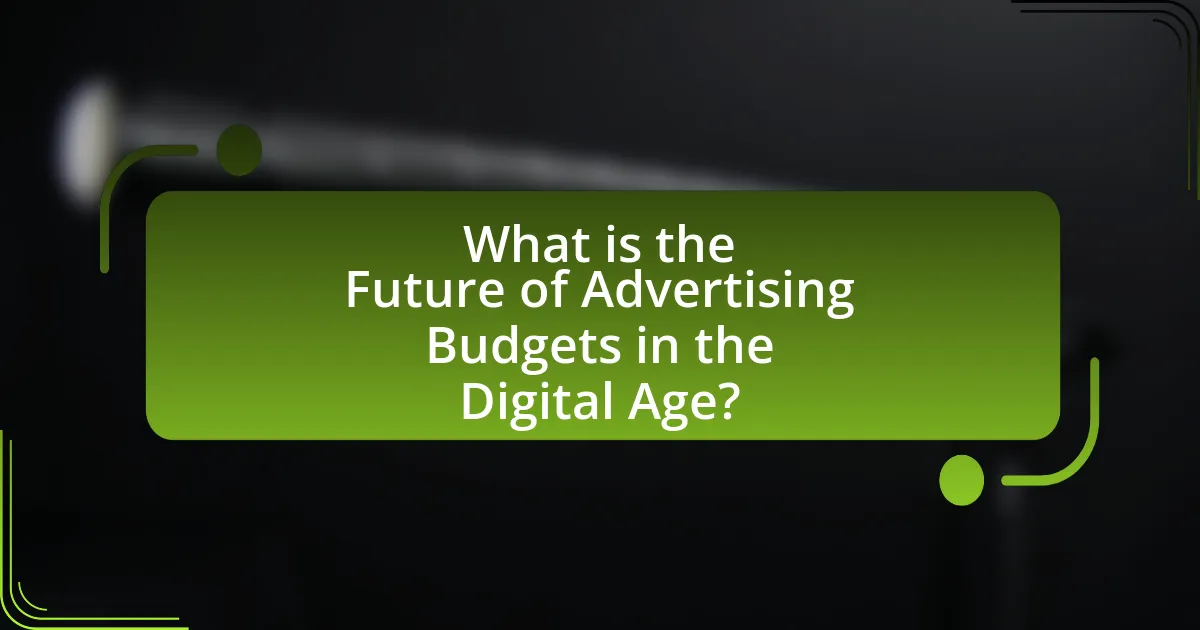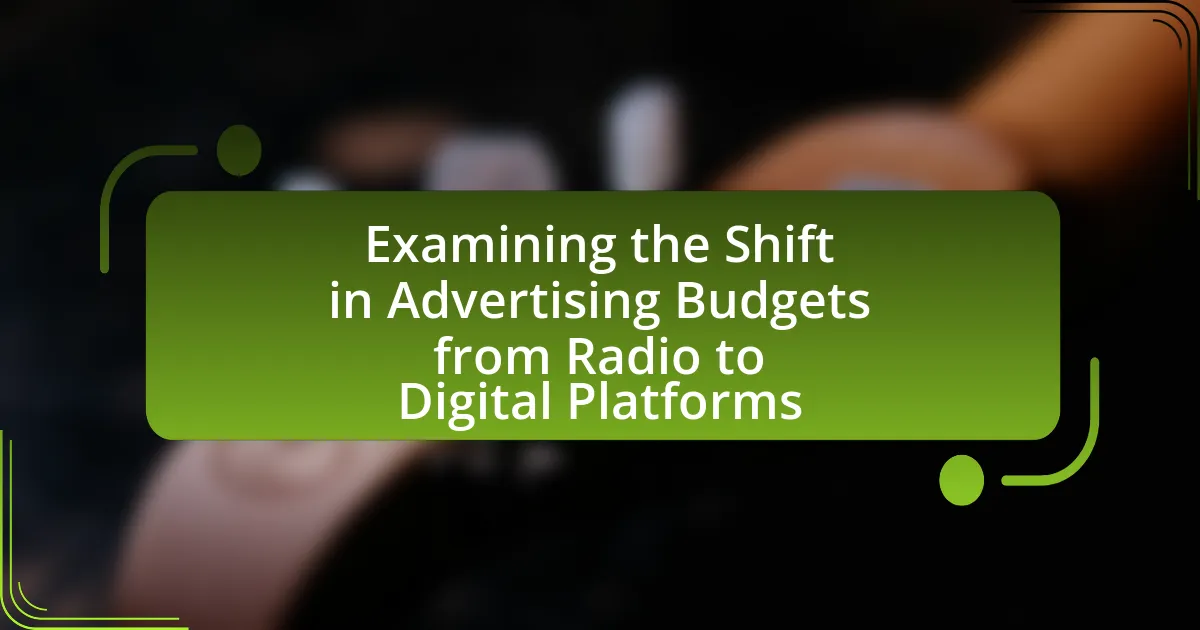The article examines the significant shift in advertising budgets from radio to digital platforms, highlighting that digital ad spending in the United States reached approximately $200 billion in 2022, compared to around $10 billion for radio. It discusses the reasons behind this transition, including enhanced targeting capabilities, measurable results, and changing consumer behavior favoring digital media. Key differences between radio and digital advertising are outlined, such as audience reach, engagement levels, and cost implications. The article also explores emerging trends in digital advertising, the role of data analytics, and the challenges advertisers face in adapting to this new landscape. Finally, it provides insights into the future of advertising budgets and best practices for optimizing digital advertising strategies.

What is the Shift in Advertising Budgets from Radio to Digital Platforms?
The shift in advertising budgets from radio to digital platforms is significant, with digital advertising spending surpassing radio expenditures. In 2022, digital ad spending reached approximately $200 billion in the United States, while radio advertising was around $10 billion. This trend reflects advertisers’ preference for digital platforms due to their ability to target specific audiences, track performance metrics, and engage consumers through various formats such as social media, search engines, and video content. The increasing consumption of digital media, particularly on mobile devices, further accelerates this transition, as advertisers seek to meet audiences where they spend most of their time.
Why are advertisers moving their budgets from radio to digital platforms?
Advertisers are moving their budgets from radio to digital platforms primarily due to the increased targeting capabilities and measurable results offered by digital advertising. Digital platforms allow advertisers to reach specific demographics with precision, utilizing data analytics to track engagement and conversion rates effectively. For instance, a report by eMarketer indicates that digital ad spending surpassed traditional media, including radio, as advertisers seek higher return on investment (ROI) and better audience insights. This shift is further supported by the growing consumption of digital content, with Statista reporting that over 80% of adults in the U.S. engage with digital media daily, making it a more attractive option for advertisers aiming to maximize their reach and impact.
What factors are driving the shift in advertising preferences?
The shift in advertising preferences is primarily driven by the increasing effectiveness and reach of digital platforms compared to traditional media like radio. Digital platforms offer targeted advertising capabilities, allowing advertisers to reach specific demographics with precision, which enhances engagement and conversion rates. According to a report by eMarketer, digital ad spending surpassed traditional media for the first time in 2019, reflecting a growing preference for measurable and data-driven advertising strategies. Additionally, the rise of mobile usage and social media has transformed consumer behavior, making digital channels more appealing for advertisers seeking to connect with audiences in real-time.
How has consumer behavior influenced this transition?
Consumer behavior has significantly influenced the transition from radio to digital platforms in advertising by driving demand for more personalized and interactive content. As consumers increasingly prefer on-demand access to information and entertainment, advertisers have shifted their budgets to digital platforms that offer targeted advertising capabilities. For instance, a study by eMarketer in 2021 indicated that digital ad spending surpassed radio ad spending for the first time, reflecting consumer preferences for platforms like social media and streaming services that allow for tailored messaging. This shift is further supported by data showing that 80% of consumers are more likely to engage with ads that are personalized to their interests, highlighting the importance of consumer behavior in shaping advertising strategies.
What are the key differences between radio and digital advertising?
Radio advertising primarily relies on audio content broadcasted through radio waves, while digital advertising utilizes online platforms to deliver targeted ads through various formats such as display, video, and social media. The key differences include audience targeting; digital advertising allows for precise targeting based on user behavior and demographics, whereas radio advertising generally reaches a broader audience without specific targeting capabilities. Additionally, measurement and analytics differ significantly; digital advertising provides detailed metrics on engagement and conversion rates, while radio advertising lacks comprehensive tracking methods. According to a 2022 report by eMarketer, digital ad spending surpassed radio ad spending, highlighting the shift in advertising budgets towards more measurable and targeted digital platforms.
How do audience reach and engagement compare between the two mediums?
Audience reach and engagement differ significantly between radio and digital platforms. Digital platforms typically offer broader audience reach due to their global accessibility and the ability to target specific demographics through data analytics. For instance, as of 2023, digital advertising is projected to reach over 4.9 billion users worldwide, compared to radio’s reach of approximately 1.3 billion listeners. Engagement levels also favor digital platforms, where interactive features such as likes, shares, and comments enhance user participation. Research indicates that digital ads can achieve engagement rates of up to 10%, while radio engagement remains around 2-3%. These statistics demonstrate that digital platforms not only reach a larger audience but also foster higher levels of engagement compared to traditional radio.
What are the cost implications of advertising on radio versus digital platforms?
Advertising on radio typically incurs higher costs compared to digital platforms. Radio advertising often involves expenses such as production costs for commercials, airtime fees, and potential additional charges for prime slots, which can range from hundreds to thousands of dollars depending on the station and time of day. In contrast, digital advertising offers more flexible pricing models, including pay-per-click and cost-per-impression, allowing advertisers to set budgets that can be as low as a few dollars per day. According to a report by eMarketer, digital ad spending is projected to surpass $200 billion in the U.S. by 2023, reflecting a significant shift in budget allocation towards more cost-effective digital channels. This data illustrates the growing preference for digital platforms due to their lower entry costs and measurable ROI compared to traditional radio advertising.
What trends are emerging in digital advertising as a result of this shift?
Emerging trends in digital advertising due to the shift from radio include increased investment in programmatic advertising, a focus on personalized content, and the rise of video advertising. Programmatic advertising, which automates the buying and selling of ad space, has seen a significant uptick, with eMarketer reporting that it accounted for over 80% of digital display ad spending in 2022. Personalized content is becoming essential as advertisers leverage data analytics to tailor messages to specific audiences, enhancing engagement and conversion rates. Additionally, video advertising is gaining prominence, with a forecasted growth rate of 20% annually, driven by platforms like YouTube and TikTok, which cater to consumer preferences for visual content. These trends reflect the ongoing evolution of digital advertising as brands adapt to changing consumer behaviors and preferences.
How are social media platforms adapting to increased advertising budgets?
Social media platforms are adapting to increased advertising budgets by enhancing their advertising tools and targeting capabilities. For instance, platforms like Facebook and Instagram have introduced advanced analytics and machine learning algorithms that allow advertisers to reach specific demographics more effectively. According to eMarketer, digital ad spending in the U.S. is projected to surpass $200 billion in 2023, indicating a significant shift from traditional media. This trend compels social media companies to innovate their ad offerings, such as implementing interactive ad formats and optimizing user engagement metrics to attract larger budgets from advertisers.
What role do data analytics play in digital advertising strategies?
Data analytics play a crucial role in digital advertising strategies by enabling marketers to understand consumer behavior and optimize ad performance. Through the analysis of data such as user demographics, engagement metrics, and conversion rates, advertisers can tailor their campaigns to target specific audiences more effectively. For instance, a study by eMarketer found that businesses using data-driven marketing strategies see a 20% increase in ROI compared to those that do not. This demonstrates that leveraging data analytics not only enhances targeting precision but also improves overall campaign effectiveness, making it an essential component of modern digital advertising.

How is the Advertising Industry Responding to the Shift?
The advertising industry is responding to the shift from radio to digital platforms by reallocating budgets towards digital advertising channels. This transition is evidenced by a significant increase in digital ad spending, which reached approximately $200 billion in the United States in 2022, surpassing traditional media expenditures. Companies are investing in data-driven strategies, utilizing analytics and targeted advertising to enhance engagement and reach specific demographics more effectively. Additionally, the rise of social media and programmatic advertising has prompted advertisers to adopt innovative formats and interactive content, further aligning their strategies with consumer behavior trends.
What strategies are advertisers employing to maximize their digital budgets?
Advertisers are employing data-driven targeting and optimization strategies to maximize their digital budgets. By leveraging analytics and consumer behavior data, advertisers can identify specific audience segments, allowing for more precise ad placements and improved return on investment. For instance, a study by eMarketer found that targeted advertising can lead to a 50% increase in conversion rates compared to non-targeted approaches. Additionally, advertisers are utilizing programmatic buying, which automates the ad purchasing process, ensuring that budgets are spent efficiently by targeting the right audience at the right time. This method has been shown to reduce costs by up to 30% compared to traditional ad buying methods.
How are advertisers leveraging targeted advertising in digital spaces?
Advertisers are leveraging targeted advertising in digital spaces by utilizing data analytics and user behavior insights to deliver personalized ads to specific audience segments. This approach allows advertisers to reach potential customers more effectively, as studies show that targeted ads can increase conversion rates by up to 50%. By analyzing demographic information, online behavior, and preferences, advertisers can create tailored campaigns that resonate with individual users, leading to higher engagement and return on investment.
What new technologies are being adopted to enhance digital advertising effectiveness?
New technologies being adopted to enhance digital advertising effectiveness include artificial intelligence (AI), machine learning, and programmatic advertising. AI and machine learning enable advertisers to analyze vast amounts of data for better targeting and personalization, leading to increased engagement rates. For instance, a study by eMarketer found that programmatic advertising accounted for over 80% of digital display ad spending in 2021, demonstrating its growing importance in optimizing ad placements and maximizing return on investment. Additionally, advancements in augmented reality (AR) and virtual reality (VR) are providing immersive advertising experiences that capture consumer attention more effectively.
What challenges do advertisers face when transitioning from radio to digital?
Advertisers face several challenges when transitioning from radio to digital, primarily including audience fragmentation, measurement difficulties, and adapting creative strategies. Audience fragmentation occurs as digital platforms host diverse content, making it harder for advertisers to reach a concentrated audience compared to the more unified listener base of radio. Measurement difficulties arise because digital advertising metrics can be complex and less straightforward than radio’s traditional metrics, complicating the assessment of campaign effectiveness. Additionally, adapting creative strategies is essential, as digital formats often require different approaches to engage users effectively, which can be a significant shift for advertisers accustomed to radio’s audio-only format.
How do issues of ad fatigue and saturation affect digital campaigns?
Ad fatigue and saturation negatively impact digital campaigns by reducing audience engagement and effectiveness. When consumers are repeatedly exposed to the same advertisements, their interest diminishes, leading to lower click-through rates and conversion rates. Research indicates that ad fatigue can result in a 50% decrease in engagement after just a few exposures. Additionally, saturation occurs when the same audience is bombarded with ads across multiple platforms, causing them to become desensitized and less responsive. This phenomenon can lead to wasted advertising budgets, as brands struggle to capture attention in an oversaturated market.
What are the potential pitfalls of relying heavily on digital advertising?
Relying heavily on digital advertising can lead to several potential pitfalls, including oversaturation, ad fatigue, and privacy concerns. Oversaturation occurs when consumers are bombarded with ads, leading to diminished effectiveness and engagement. According to a study by HubSpot, 91% of consumers feel that ads are more intrusive today than ever before, which can result in negative brand perception. Ad fatigue happens when audiences become desensitized to repetitive messaging, causing a decline in click-through rates and conversions. Furthermore, privacy concerns arise as data collection practices become more scrutinized; a survey by Pew Research Center found that 79% of Americans are concerned about how their data is being used by advertisers. These factors highlight the risks associated with an overreliance on digital advertising strategies.

What is the Future of Advertising Budgets in the Digital Age?
The future of advertising budgets in the digital age is increasingly focused on digital platforms, with projections indicating that digital ad spending will surpass traditional media by a significant margin. According to eMarketer, digital advertising is expected to account for over 60% of total ad spending by 2024, reflecting a shift from traditional channels like radio and print. This transition is driven by the growing effectiveness of targeted advertising, real-time analytics, and the ability to engage consumers through various digital touchpoints. As businesses recognize the higher return on investment associated with digital campaigns, they are reallocating budgets accordingly, further solidifying the dominance of digital advertising in the marketing landscape.
How will the balance of advertising budgets evolve in the coming years?
The balance of advertising budgets will increasingly favor digital platforms over traditional media, particularly radio, in the coming years. This shift is driven by the growing effectiveness of digital advertising, which allows for better targeting and measurable results. According to eMarketer, digital ad spending is projected to surpass $500 billion by 2024, while radio advertising is expected to decline, with a forecasted decrease of 5% in revenue over the same period. This trend indicates a clear movement of funds from traditional to digital channels as advertisers seek higher returns on investment.
What predictions can be made about the future of radio advertising?
Predictions about the future of radio advertising indicate a continued decline in traditional radio ad spending as advertisers increasingly shift budgets to digital platforms. According to eMarketer, U.S. radio ad spending is projected to decrease by 5.4% in 2023, while digital audio advertising is expected to grow by 25.1% during the same period. This trend suggests that radio advertising will face challenges in maintaining its market share as advertisers prioritize targeted and measurable digital options. Additionally, the rise of podcasting and streaming services is likely to further divert advertising dollars away from traditional radio, reinforcing the shift towards digital platforms.
How might emerging technologies reshape advertising strategies?
Emerging technologies are reshaping advertising strategies by enabling more targeted and personalized marketing approaches. For instance, advancements in artificial intelligence and machine learning allow advertisers to analyze consumer data more effectively, leading to tailored ad experiences that resonate with individual preferences. According to a report by eMarketer, digital ad spending is projected to surpass traditional media, with a significant shift towards programmatic advertising, which automates the buying and selling of ads based on real-time data. This transition illustrates how emerging technologies facilitate more efficient ad placements and optimize return on investment for advertisers.
What best practices should advertisers follow when shifting budgets to digital platforms?
Advertisers should prioritize data-driven decision-making when shifting budgets to digital platforms. This involves analyzing performance metrics from previous campaigns to identify which channels yield the highest return on investment (ROI). For instance, a study by eMarketer found that digital ad spending in the U.S. is projected to reach over $200 billion in 2023, indicating a significant shift in consumer engagement towards digital media. Additionally, advertisers should allocate budgets flexibly, allowing for real-time adjustments based on campaign performance. This adaptability is crucial, as digital platforms provide immediate feedback on ad effectiveness. Furthermore, leveraging audience segmentation and targeting capabilities can enhance campaign precision, ensuring that ads reach the most relevant consumers. By following these best practices, advertisers can effectively navigate the transition from traditional media to digital platforms, maximizing their advertising impact.
How can advertisers effectively measure the success of their digital campaigns?
Advertisers can effectively measure the success of their digital campaigns by utilizing key performance indicators (KPIs) such as conversion rates, click-through rates (CTR), and return on investment (ROI). These metrics provide quantifiable data that reflects the effectiveness of the campaigns. For instance, a study by HubSpot found that businesses that actively track their KPIs are 12 times more likely to see a positive return on their marketing investment. Additionally, tools like Google Analytics enable advertisers to analyze user behavior and engagement, further enhancing their ability to assess campaign performance accurately.
What are the key considerations for optimizing digital advertising spend?
To optimize digital advertising spend, key considerations include targeting accuracy, budget allocation, performance metrics, and platform selection. Targeting accuracy ensures that ads reach the intended audience, which can significantly enhance engagement and conversion rates. For instance, utilizing data analytics can refine audience segments, leading to more effective campaigns. Budget allocation involves distributing funds across various channels based on their performance; research indicates that reallocating 10-20% of the budget to high-performing channels can yield better returns. Performance metrics, such as click-through rates and return on ad spend, provide insights into campaign effectiveness, allowing for real-time adjustments. Lastly, selecting the right platforms is crucial; platforms like Google Ads and Facebook Ads offer diverse targeting options and measurable outcomes, making them popular choices for advertisers.



